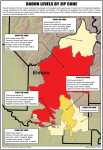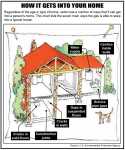Battling the invisible threat

Recent testing in Elmore County raised concerns by state environmental officials regarding elevated levels of radon gas present in some homes across the county.
Information provided by the Idaho Department of Health and Welfare follows months of testing of homes across the state aimed at detecting how much of the radioactive gas had seeped inside them.
While these voluntary tests included 235 homes -- less than two percent of residences in the county -- more than 46 percent of them tested positive for increased levels of radon, said Jim Faust, indoor environment program manager with the Idaho Department of Health and Welfare.

Radon gas comes from the natural decay of uranium found in nearly all soils. It typically moves up through the ground to the air but can seep into home through cracks and other holes in the foundation where it gets trapped and can build up over time.
The Environmental Protection Agency in Washington, D.C., estimates that nearly one out of every 15 homes in the United States has elevated radon levels.
The danger comes from the radioactive particles that can get trapped in people's lungs as they breathe, according to information provided by the EPA. As they break down, these particles release small bursts of energy, which can damage lung tissue and lead to lung cancer.
Exposure to radon can remain undetected for years until people show signs of late-stage lung cancer, Faust said. Each year in the United States, more than 21,000 people are diagnosed with lung cancer caused by prolonged exposure to this gas.
"Not everyone exposed to elevated levels of radon will develop lung cancer," the EPA said. However, the agency added that the amount of time between exposure and the onset of the disease may take years. Smoking combined with radon poses a more serious health risk, the agency added.
"The only way to know if radon is in your home is to test for it, because you can't see, smell or taste it," he added. "What you don't know can kill you."
The average radon level in a home hovers around 1.3 picocuries per liter, or pCi/L, with levels outdoors dropping to about 0.4 pCi/L. The EPA recommends that homeowners take steps to mitigate the radon risk in their house when levels reach at least 4 pCi/L.
According to the state health and welfare department, Elmore County ranked ninth out of 44 counties from a total radon risk perspective. The methodology used to rank the counties wasn't immediately known.
Topping this list was Clark County, which had a 100 percent rating of homes with radon levels above 4 pCi/L. However, only four homes were actually tested.
More definitive data came from areas like Coeur d'Alene, which ranked at the top of the radon risk chart out of all testing done in Kootenai County. Voluntary testing in that county included more than 1,700 homes with more than 63 percent of them posting radon levels above the 4 pCi/L threshold.
Other parts of the state showing elevated radon levels during the recent testing included Blaine County in which 56 percent of the 1,540 houses had high radon levels. In Ada County, one out of every fives homes that were tested showed similar results.
According to test results released this month by the state health and welfare department, 49 percent of the 220 homes that were tested within the 83647 ZIP Code area in Elmore County showed radon levels above 4 pCi/L with an average level of 9.6 pCi/L.
Meanwhile, seven homes tested in the 83623 ZIP Code area showed similar results. Of the seven homes tested, three of them had radon levels above the 4 pCi/L threshold.
According to Faust, any home may have a radon problem.
"It doesn't matter if it's a new or old home or one that has a crawl space or a basement," he said. All of them can have a potential radon risk.
Faust emphasized that every home can be fixed to mitigate the hazard and can be done my homeowners themselves or by calling in a licensed contractor.
To alleviate the problem, plastic tarp or other materials are used to trap the gas with PVC piping diverting it safely outdoors where it naturally dissipates.
"Radon reduction systems work, and they are not too costly," the EPA reported. "Some radon reduction systems can reduce radon levels in your home by up to 99 percent. Even very high levels can be reduced to acceptable levels."
